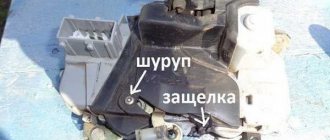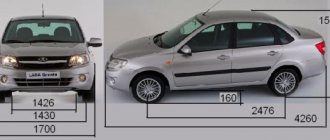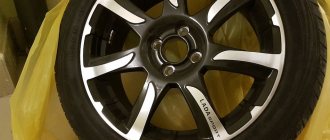I changed the clutch: the gears do not engage after replacement
Owners of cars with a manual transmission often encounter the problem of shifting gears, namely, after starting the internal combustion engine, one or more gears may not engage or engage, but with great effort. Also, when turning on the speeds, extraneous noise, vibrations, etc. may appear.
The problem may appear suddenly or progress gradually. Difficulties when switching gears can occur both on a “cold” and on a “warm” gearbox. In this case, the speed with the engine turned off will be switched on without much effort.
Next, we will look at why such malfunctions and failures occur, for what reason the gears do not engage when the engine is running, after replacing the clutch, first gear does not engage well, etc.
What did you get?
The design of the gearbox was not only optimized and made more reliable, but also almost completely eliminated unpleasant vibrations on the lever and the car body. The backlash has become smaller and the shifts are clearer. It is worth noting that the use of a modernized gearbox on the Lada Granta and Lada Kalina 2 entailed an increase in the cost of these cars by an average of 5,000 rubles. By the way, the cable box is not installed on the Lada Priora; this car uses a 2180 manual transmission with rigid rods.
Let us remind you that according to reviews, the first copies of the modified gearbox were not entirely successful. The owners noticed a decrease in vibrations, but encountered a new problem: the box began to howl. After this, AvtoVAZ made changes to the design, but the sediment remained...
The owner installed a new clutch: the gears do not engage
So, the problem of gear shifting can arise due to serious malfunctions, such as: failure of synchronizers, wear or breakage of gears, jamming of gearbox components and mechanisms when selecting a gear. In this case, to identify breakdowns, it is necessary to dismantle the box with subsequent “defection” or replacement of damaged components.
If the breakdown is associated with a malfunction of the clutch, the failed elements are replaced, or the clutch is replaced with a new one. However, even after replacement, problems may occur.
The problem of shifting gears after replacing the clutch in full and incomplete sets
Drivers often encounter this problem: when a car owner has installed a new clutch, the gears do not engage. There may be several reasons for this. Let's look at each in more detail.
- First of all, the release bearing. The clutch disc has been replaced, but the gears still do not engage or are not engaged completely. One of the reasons may be a failed clutch pressure (release) bearing.
This element is located on the axis of rotation. Thanks to the clutch fork, the bearing moves together with the release clutch. The bearing disengages the clutch disc from engaging the basket (the clutch engages and disengages). There are two types of bearings:
- roller bearing (works due to a rigid connection between the rods);
- hydraulic bearing (creates force using a hydraulic system);
When you press the clutch pedal on a car with the engine running, a characteristic knocking or noise appears. If the bearing is severely worn, it may jam and it will no longer perform its functions as a transmission device between the drive and the clutch.
- Clutch basket. The basket through which the flywheel and disc are connected and disconnected is one of the main components in the clutch design.
The basket consists of: a pressure plate, a diaphragm spring and a casing. The clutch basket does not wear out as quickly as the clutch disc. If, after changing the clutch disc, the problem with gear shifting remains, you need to pay attention to the basket.
Often, basket malfunction is associated with wear of the petals (deformation, overheating, etc.). The basket ceases to perform its functions as it heats up, and as a result, the pressure disk is not completely retracted. The problem is solved by replacing the basket. If the problem is not corrected in time, then over time the release bearing and clutch disc may become damaged.
- After replacement, the clutch disc turned out to be a little thicker or there is a defect in the clutch basket (some petals may be slightly lower than the others).
- Adjusting the backstage. The link can be adjusted either at a service station or independently. There are two adjustment methods: adjustment in reverse gear, adjustment in first gear (there is no possibility of engaging reverse gear).
- Wear of the flywheel (the flywheel is connected to the clutch and is its support). The flywheel sphere, in contact with the clutch disc, is subjected to heavy loads. As a result, there is difficulty switching gears, slipping, etc.
If the rear plane of the flywheel is damaged, it is reground on a machine in compliance with all standards. In cases where the flywheel crown is worn out, then it is replaced.
Useful video
Published May 31, 2018
Like VAZ 2114 engage reverse gear
Box VAZ 2114: device, diagram, repair
VAZ 2114/2115 is distinguished by normal service, equipped with a reliable engine and gearbox. The box for VAZ 2114 / 2115 provides the best performance for your device. In other words, the unique VAZ 2115 box is actually twice the amount of money used.
Design features of the gearbox
VAZ 2114 (restyling of VAZ 2109) operates on the Russian car market, which is equipped with a manual transmission. The peculiarity of this device is that it copes well with the loads that fall there.
Sometimes the box on a VAZ 2114 needs to be serviced. The gearbox on a VAZ includes the following main elements:
- How to Engage Reverse Gear on a VAZ 2112
- settling tank;
- Back cover;
- gears/gears;
- differential;
- shafts;
- transmission
Manual transmission is divided into the following types:
- 4-speed;
- 5 speeds;
- 6 speeds.
Each of these types of boxes have different supports; drain plugs are installed in different compartments.
Selection of gearbox oil
The oil level should be monitored from time to time; It is recommended to top up as needed. When the car reaches 60,000 kilometers, a complete oil change will be required.
It should be noted that early wear of mechanical components on the VAZ 2114 is caused by a harsh drive or a sharp change in the gear shift lever.
The gearbox for this version of the car works perfectly with GL-4 mineral oil. This helps extend the life of the box. Required parameters: 75W90, 80w85, 85w90. Always choose lubricants for the gearbox; you must take into account the criteria by which the car will be used, and pay attention to the viscosity of the transmission oil.
Needs repair work
The VAZ 2114 gearbox is subject to repair. Typically this procedure involves installing new gears and bearings. Repairing the VAZ 2114 gearbox is advisable if the following manifestations begin to be observed:
- tightness when operating manually gearbox
; - knocking noise when changing gears or in a certain gear;
- if the synchronizer fails, the corresponding crisis may fall;
- if lubricants have lost their characteristics, an increase in hum (often neutral) is observed.
For any of these manifestations, it is recommended to contact a service center to diagnose the entire automatic metering system.
The main stages of removing the box
How to remove the gearbox on a VAZ 2114? To disassemble the box yourself, the driver must equip himself with screwdrivers, nuts, and WD-40 liquid. Stages of dismantling the box:
- VAZ can be placed on an overpass.
- You need to turn off the battery and remove it.
- Pour the oil out of the box.
- Removing the starter, protective shell, connecting cable.
- They are present on the cruise control sensor, the reverse sensor wiring is disconnected.
- The reaction rod bolt must be removed.
- Dismantling the all-wheel drive.
Removing the box takes about 5 hours. Reverse assembly.
How to change a manual transmission correctly. Video driving lesson No. 6
In this case, a lesson. list correctly
on a car with a manual transmission .-.
How to change gears on a VAZ, ZAZ
Gearbox lesson .
Thus, in order to increase the capacity of the box installed on a VAZ, the owner of the vehicle must undergo timely maintenance and change the oil. It is recommended to give preference to synthetic oils. If you want to disassemble the gearbox, there is an option without assistance, following our customer's instructions.
VAZ 2115 | Transmission
Gear shift and lever position
Manual box
The position of the gear shift lever is shown on the handle. Lift the ring under the handlebar handle before engaging reverse gear.
When changing gears, fully depress the clutch pedal, then release it slowly. It is not recommended to drive the car with one hand on the gearshift lever; this increases wear on the gearbox.
When shifting from fifth to fourth gear, do not push the lever sideways, so engage second gear, which causes the engine to overspeed and damage it.
Before engaging reverse gear, make sure the vehicle is at rest and your foot is not on the gas pedal. Move the lever from neutral to the right until it bends, then lock the rear
move.
The table below shows the speeds at which the next gear should be engaged for maximum fuel economy.
Transmission. Automatic transmission
At the center of the switch lever is an illuminated dial that shows the position markings of the selection ranges.
P ?? Parking R?? rear
move N?? Neutral position
Forward gears:
D?? First. 4th gear 3?? First. 3rd gear 2?? First. 2nd gear 1?? only 1st broadcast
You cannot set the P, R or N position while driving. Resetting the movement position leads to tragedy or damage to the box.
Select lever positions
Depressing the accelerator pedal while the selector lever is moved causes excessive wear on the transmission.
Always keep your foot on the brake pedal to establish the driving position. Keep your hand firmly on the shift lever as this will cause wear to the box.
Gearbox lever
Between the steering gear and acceleration you need to shift for a very short time to change gears.
D ›3 N› RR ›PP› R 3 ›2
This position can only be set when the vehicle is stationary. The lever and junction box are blocked. And perhaps the engine was started.
You prefer this position only when the car is stationary. Press the button on the lever handle.
Before you start, wait a moment to enable it to broadcast
reverse gear.
In this case, the engine position is disconnected from the box. And perhaps the engine was started. Use the handbrake to prevent the vehicle from rolling downhill. To avoid overheating of the engine and gearbox, it is necessary to set N positions for long vehicle stops (for example, in traffic jams). Waiting at a traffic light, position D.
This position is used for everyday driving. The car enters first gear, after which the gears automatically shift between 2nd, 3rd and 4th gears. The switching moment depends on the position of the gas pedal and the speed of movement.
Solving this problem, 4th gear is locked. The car lingers in first gear and then automatically shifts between 2nd and 3rd gears. Position 3 is recommended when driving on zigzag roads and in heavy city traffic. When the lever is moved from position D to position 3, the transmission immediately shifts into 3rd gear, causing a strong engine braking effect. This does not have to be done at speeds above 130 km/h.
This position is recommended when driving on mountain roads. With all this power, the engine is better used and the engine braking effect is increased. The transmission automatically shifts between first and second gears. 3rd and 4th gears are locked.
Moving the lever from position D or from position 3 to position 2.7, switching from third to second gear occurs in advance only at a speed below the set speed, in order to avoid increasing the engine speed to unacceptable values.
This position is recommended when ascending steep slopes and descending from the mine. On the plus side, the engine is effectively braked and constant gear changes are eliminated, which leads to overheating of the water in the gearbox.
Modern cars are equipped with different types of transmissions. It can be automatic with the well-known “donut torque converter”, continuously variable transmission, DSG (Audi concern), tiptronic and so on. But no matter how much gearboxes are improved, the classic “mechanics” is rightfully considered one of the most reliable. All domestically produced cars are equipped with this. The exception is the latest generations of Kalina and Vesta in top trim levels, where an automatic transmission is installed. The VAZ-2114, regardless of the year of manufacture and configuration, was always equipped with a manual transmission. Well, let's look at its design, operating principle and operating features.
What's the result?
As you can see, if such a problem arose when the owner replaced the clutch and the gears do not engage, it is necessary to determine the cause. First of all, you shouldn’t immediately rush to change the clutch again.
The fact is that there are many reasons why the gears do not turn on or are not turned on completely. In any case, to identify faults, it is first necessary to conduct a complete diagnosis of the gearbox. As part of the checks, it is necessary to separately take into account which clutch elements were changed, whether adjustments were made, adjustments to the rocker, etc.
Types of clutch drive. If the clutch pedal falls, the clutch has become soft, problems have arisen with the clutch: causes and repair of major faults.
How to adjust the clutch pedal, what adjustment is needed for: clutch functions, clutch pedal adjustment (free play and total travel).
Clutch disc: purpose and device. How to replace a clutch disc, replace this element yourself. Recommendations.
Car clutch: purpose, types, design, principle of operation. Frequent clutch malfunctions in the vehicle transmission system, signs of problems.
Clutch master cylinder (MCC): how it works and works. Signs of malfunctions of the clutch hydraulic master cylinder, diagnostics, repair, replacement.
How is the clutch implemented in the transmission device on cars with automatic transmission compared to a manual or robotic transmission. Features and differences.
Repair or replacement
If, during checking the condition of the box, serious damage to its elements was revealed, then serious repairs cannot be avoided.
It should be immediately noted that independent dismantling, repair and reassembly of a gearbox requires not only very good equipment (nominally a pit or overpass, a lifting device, as well as a large set of tools are required), but also very serious knowledge.
That is why, if the gears of a VAZ 2114 do not engage, such repairs should be entrusted to specialists from car service centers.
Gearbox disassembled
- Symptoms of malfunction and connection diagram of the speed sensor on the VAZ 2114
It should be remembered that independent repair or replacement of the gearbox automatically leads to the loss of all warranty obligations from the manufacturer. For this reason, repairs to a car that is under warranty should be entrusted to branded repair shops.
If we talk about the choice between repair and complete replacement of the unit, then in most cases you should choose the first option. This is due to two reasons. Firstly, the cost of a completely new box exceeds 15 thousand rubles. (moreover, this amount is indicated without taking into account the cost of its installation). In any case, repairs will be much cheaper. And secondly, complete wear of the box (to a state unsuitable for repair) is extremely rare.
The cost of the repair work itself varies from service to service and depends on:
- the size of the locality (and, as a consequence, the presence of competitors);
- type of breakdown;
- the size of the car service (and whether it is official);
- additional clauses in the terms of the contract.
Gearbox disassembly
After replacing the clutch, gears do not engage: reasons
den1s_55
pull the cable
yes, I’m trying now, I write messages during smoke breaks) So far there is no result, the 4th speed has become difficult to engage. the rest doesn't turn on!
Added after 18 minutes 20 seconds:
We adjusted that 3,4,5 turns on quite hard. 1,2 are not included. The disk was installed correctly 99%. What else could it be?
Well, then it could be: 1. The clutch was assembled crookedly and made of “shit”. 2. The transmission gear selection is crooked and not adjusted in any way. 3. Broken clutch fork. 4. The clutch drive is not CORRECTLY adjusted (that is, the cable). 5. Heavenly punishment.
Here's the question: did you do it yourself, or at the station? It’s just that if they are at the station, then there is a reason to spoil their brains. If you do it yourself. then why did you go there?
I would vote for adjusting the gear selector rod. How to adjust: you disconnect it at the bottom, stick it on the rear box with pliers from below, snap the lever in the cabin onto the rear one, and combine it under the car.
What sounds are there from under the gearbox and clutch? Or is it just stupid not to stick the gear in? And all the same, where is such confidence that the driven disk was not turned over then? Clutch pedal position in studio. How does the clutch fork move on the box, and does it move at all? There are no miracles, we changed 3 parts and the machine stopped working. Maybe the basket was bent into a hollow, or maybe it was not from the same car that was installed.
I almost forgot: 6. The input shaft didn’t hit the flywheel
den1s_55
pull the cable
yes, I’m trying now, I write messages during smoke breaks) So far there is no result, the 4th speed has become difficult to engage. the rest doesn't turn on!
Added after 18 minutes 20 seconds:
We adjusted that 3,4,5 turns on quite hard. 1,2 are not included. The disk was installed correctly 99%. What else could it be?
Well, then it could be: 1. The clutch was assembled crookedly and made of “shit”. 2. The transmission gear selection is crooked and not adjusted in any way. 3. Broken clutch fork. 4. The clutch drive is not CORRECTLY adjusted (that is, the cable). 5. Heavenly punishment.
After replacing the clutch, gears do not engage: reasons
I changed the clutch disc and bled it, but with the engine running I couldn’t turn on the gear, not 1, not 2, not 3, not 4, not 5 and not in reverse!! and with the engine turned off, the speed turns on. I start the car with the clutch depressed and the car starts moving normally! Maybe someone has some thoughts?
carefully read clause 2.2 of the rules
The clutch circuit must be pumped under pressure, that is, pressure must be created in the brake fluid reservoir.
and for special remote ones, can you go into more detail about how this is, otherwise I pumped the brakes, pumped the pedal and opened it, then closed it and released the pedal
— Added a little later —
It’s just that this method is described everywhere
You make a similar lid for the TJ barrel and supply air from the spare tire, 1 atmosphere is enough. Or you contact a service center that has such equipment.
— Added a little later —
Well, I found instructions for the previous generation of Passats, I pumped B4 in this way on B3, but didn’t try on B5 • Check the brake fluid level in the common expansion tank, if necessary, add the level to about. • Remove the dust caps from the air bleed valve on the working cylinder and on the front left wheel brake caliper. • Carefully open the bleed valves. • Place a transparent hose onto the air bleed valve located on the disc brake caliper. • Fill the hose with brake fluid. To do this, open the air bleed valve located on the caliper. Slowly depress the brake pedal (by an assistant) and hold it in this position. Close the bleeder valve and release the brake pedal. Then open the valve again and depress the brake pedal again. Continue this process until the hose is completely filled with brake fluid. Close the hole in the hose with your finger to prevent brake fluid from spilling out. Attention: The fluid level in the compensation tank should not fall too low; if necessary, replenish the level with new brake fluid. • Place the hose that is closed with the pin on the bleeder valve on the clutch slave cylinder and open both valves. • Depress the brake pedal, close the valve on the caliper, then release the brake pedal. This process is repeated until air bubbles stop entering the compensation tank. At the same time, constantly replenish the level in the reservoir with new brake fluid. • Close the air bleed valves on the clutch slave cylinder and on the disc brake caliper. Remove the hose and place dust caps on the air bleed valves. • Lower the vehicle. • With the clutch pedal depressed, open the bleeder valve on the master cylinder and close it again as soon as brake fluid comes out. • Replenish the fluid level in the compensation tank to about. • Check the functioning of the brake system and clutch. Caution: The bleed process described here without a proper tool may leave some air in the system. This can be determined by scratching sounds when engaging gear and improper disengagement of the clutch. In this case, it is necessary to urgently remove air from the system in a workshop using an appropriate device. In the workshop, air is removed from the clutch hydraulic drive, usually using an air bleeder. The device creates pressure in the brake fluid (maximum 2.5 bar). When using the device, air is removed first from the main and then from the working cylinder
Why don't the gears shift when the engine is running?
The problem of shifting gears while the engine is running is common, especially in cars with a manual transmission. The malfunction can occur either completely unexpectedly, or gradually, making itself known by the appearance of a characteristic grinding sound and difficulties when shifting gears. In any case, without eliminating the cause of the malfunction, you will not be able to operate the car.
Cable tension and switch limit position adjustment
The most obvious and common causes of poor shifting and switch failures come down to poor settings. Index switches (when you switch to 1st gear with one press of the shift lever) are very demanding on the correct cable tension and the internal cleanliness of the jacket. Over time, the jackets and cables deteriorate, dirt and dust get inside and this inevitably leads to a deterioration in the quality of switching.
If the shifter is reluctant to throw the chain into a higher gear, then most likely you should check and tighten the cable. If this happens when switching to a lower gear, then the cable needs to be released.
Also, very often problems with switching to the highest and lowest sprocket can be caused by incorrect settings of the extreme position adjusting screws.
For what reasons do interruptions occur?
There can be many reasons why gears do not shift when the engine is running. However, all of them, in one way or another, are connected with the two most important units of the car - the engine or gearbox. In case of serious damage, you should contact a good car service.
If the problem is in the gearbox, it will need to be removed for further disassembly and troubleshooting. If the problem is with engine components, they may need to be replaced. However, there are cases when, to eliminate a malfunction, it is enough to carry out preventive maintenance: removal, lubrication and careful adjustment of the components.
Operational and design features
Among the main innovations of such a development as a cable-driven gearbox is a reduction in the volume of oil used in the box. Previously, the manufacturer assumed the use of mineral fluid in a volume of 3 liters, but now the unit requires semi-synthetic fluid with the amount reduced to 2.2 liters.
Many Lada Granta owners are concerned about the question that has arisen: what type of oil should they choose when replacing a progressive gearbox to ensure its normal functionality? The manufacturer continually recommends using fluids with a viscosity parameter of “75W-85” in accordance with the “GL-4” specification.
Troubleshooting methods
Once the source of the problem has been found, you can begin to eliminate the causes of the malfunction.
If the problem is in the engine
The simplest cause of problems when shifting gears can be a leak of brake fluid, which is the working fluid for the clutch. If there is insufficient lubrication in the clutch hydraulic system, it will not engage fully. Therefore, first check the fluid level in the car's tank. If the level is low, check for leaks, repair defects and bleed the clutch. When the fluid level is at the normal level, the clutch elements should be inspected.
Problems with switching to automatic transmission
Shifting problems with automatic transmissions are not uncommon. Problems with the automatic machine arise for several reasons.
- backstage malfunction . This mechanism is the most problematic in old-type automatic transmissions. To eliminate the malfunction, the unit will need to be replaced. In most cases, it will be necessary to dismantle the gearbox for these purposes;
- insufficient oil level . The presence of lubricant leaks on the automatic transmission housing may indicate wear of the sealing gaskets, which are not difficult to replace yourself. After this, you need to change the oil in the box. Also, owners of cars with an automatic transmission are recommended to visually inspect the gearbox for oil leaks at least once every 2000 km;
- problems with the transmission control unit can ultimately cause the automatic transmission to completely lock up. To fix the problem, you will need to replace the failed mechanism and thoroughly inspect the electrical part of the gearbox.
Important! To solve problems with automatic transmission, it is recommended to conduct computer diagnostics of transmission faults.
If you have a mechanic
Gears shift poorly in a car with a manual transmission for three reasons. The first of these is a malfunction of the clutch when it does not completely disengage (drive). The first sign of this malfunction is that the reverse gear is engaged with a characteristic crash. The rear one reacts to this anomaly more noticeably than other gears, because it is the only one not equipped with a synchronizer.
The second reason is a defect in the gear selection mechanism of the gearbox. And finally, the third is excessive wear of the gearbox synchronizers.
There are also several clutch malfunctions in which manual transmission gears shift poorly:
- Air in the clutch release hydraulic drive or fluid leakage from it. The malfunction is eliminated by replacing failed components of the hydraulic system and pumping it.
- Worn or broken clutch release fork. The part requires replacement or repair.
- Warping (runout greater than 0.5 mm) or too thick new driven disk.
- Failure of the basket (temperature deformation of the pressure plate or its distortion).
- Loss of mobility of the support bearing of the gearbox input shaft (at the end of the crankshaft to which the flywheel is attached).
- Jamming of the clutch driven disc hub on the splines of the gearbox input shaft. To eliminate the defect, clean the splines of the gearbox hub and input shaft. It wouldn’t hurt to lubricate them a little with lithol.
There is too much free play in the clutch release fork. Its value needs to be clarified with the manufacturer, since it is slightly different for different cars. Until you find out the value of this parameter for your car, set it from 5 to 8 mm. Too little free play of the fork is also undesirable, as it leads to clutch slipping and increased wear of the release bearing.
What to do if gears do not engage while the engine is running
Sooner or later, any motorist is forced to recognize the appearance of problems in the operation of the gearbox. Mechanical transmissions break down especially often, and the malfunction can occur spontaneously and unexpectedly, but more often than not, gradually, manifesting itself in various uncharacteristic sounds when shifting gears, as well as difficulties in turning them on.
If you cannot move with the engine running, you will have to find out the reason and eliminate it.
Common causes of gear shifting problems
There may be many reasons why you cannot move the gearshift lever to the working position. And they are not always associated with a malfunction of the box itself - in some cases the culprit is the clutch, sometimes the engine. In any case, to find out the cause yourself, you must have the appropriate knowledge and experience - otherwise there is a high risk that you will not be able to do this or that as a result of your actions you will have to carry out more complex and expensive repairs.
If the gears do not engage with the engine running due to a malfunction of the gearbox, it will require dismantling and troubleshooting - an operation that requires great care. The same can be said about the clutch. However, it is better to proceed to a more detailed description of possible problems and ways to eliminate them.
The main stages of removing the box
How to remove the gearbox on a VAZ 2114? To begin dismantling the box yourself, the driver must arm himself with screwdrivers, spanners, and WD-40 liquid. Stages of dismantling the box:
- A VAZ can be placed on an overpass.
- You need to disconnect the battery and remove it.
- The oil is drained from the box.
- Dismantling the starter, protective jacket, connecting cable.
- The wiring present on the speed control sensor, reverse sensor is disconnected.
- It is necessary to remove the jet thrust fixed on the bolts.
- Removing the wheel drive.
The process of dismantling the box takes about 5 hours. Assembly proceeds in reverse order.
Malfunctions when turning on gears and their elimination
The main components of a modern car are characterized by the same operating principles, despite significant differences in their design. In particular, this also applies to manual transmissions (if we do not consider rear-wheel drive cars, in which the lever is connected directly to the transmission).
Front-wheel drive vehicles can have either a longitudinal or transverse gearbox. In the latter case, a link is used for communication between the motor and the gearbox; on some models (for example, on the Ladovsky Vesta and Kalina) a cable drive is used. It is considered simpler and more reliable, but this design is not without its drawbacks and can fail.
So, let's look at the main reasons why gears do not engage when the engine is running.
Traction, drawstring
Since we have already mentioned domestic cars with a transverse power unit (from the “Nine” to the “Priora”), then when the above-mentioned problem appears, it is first necessary to begin the search for the culprits with these mechanisms.
If you notice that when the car starts moving, the gearbox lever rattles chaotically and unpleasantly, most likely it is the rocker that has flown out of its mounting location. This type of malfunction occurs especially often on cars of the Lada Samara family of the first two generations. The solution is to replace the link or fastener element with new ones. We can say that this is the most obvious and easily fixable malfunction of this kind.
On cars of later years of production, a cable is used instead of a rocker. If this cable breaks, you will not be able to engage the gear, but not only with the engine running, but also with the engine turned off. This is what will indicate that the drive cable is the likely culprit. Replacing it is not difficult, and it is inexpensive compared to other components and parts.
Insufficient transmission oil level
The box, like the engine, may lose its seal, which will lead to lubricant leakage. If there is a deficiency of it, you will feel that the gears are “stuck” with strain, since the engagement of the gears in the absence of oil occurs with great difficulty. If the problem is not corrected in time, the synchronizers will eventually fail and costly repairs will be required.
Video “How to solve the problem of poor gear shifting?”
First, we suggest finding out what is the reason why reverse or first gear is sometimes or systematically difficult to activate.
The reasons why the gear is difficult to engage may be different, let’s consider them in detail:
- If it is difficult to switch between first and second gears, the problem may be that the clutch is not fully activated. On a VAZ Priora, the reason often lies in damage or disconnection of the cable on the pedal. This problem can be identified by diagnosing it. If the pedal is sunk into the floor, the cable must be replaced.
- Failure of the drive rod for controlling the gearbox activation mechanism.
- Damage or incorrect operation of the transmission's torque rod.
- Loosening the fixing bolts on the gear selector rod lever or on the hinge. It is necessary to determine the reason why the screws may have become loose.
- Making mistakes when adjusting the gear activation drive.
- Failure or damage to plastic components that are installed on the Lada Priora gearbox control drive.
- Mistakes made when adjusting the scenes. This unit on the VAZ Priora is designed to connect the gearbox to the selector in the car interior. As a result of long-term use, the plastic bushings on the rocker could wear out.
- Failure of synchronizer elements. These mechanisms are made in the form of brass bushings, which are used for more simplified gear shifting. Brass is a soft metal and will wear out over long periods of use. If the first and reverse gears are difficult to engage, and the reason lies in the synchronizing elements, when you try to change gear, an unpleasant crunching or grinding noise will be heard. When there are no problems with activating gears, but there is an uncharacteristic sound when the gearbox is operating, then in the future you will encounter difficulty changing gears.
- Failure of bearing elements due to damage or wear. This type of malfunction is not common, but over time the bearings wear out, so every car owner can encounter it. If a part breaks, one of the transmission pulleys is no longer able to rotate, which leads to problems when activating speeds. Usually we are talking only about the first gear.
- Failure of the box shaft. This unit is not subject to wear or critical loads during its entire service life, but it may break due to a manufacturing defect. Even minor errors made by the manufacturer when assembling the vehicle can lead to shaft failure. Because of this, the car owner will face the problem of not only difficulty engaging first gear, but also a breakdown of the transmission unit as a whole.
- The reason may lie in the car's engine mounts. The power unit hangs on them and is connected to the transmission. During long-term use of the car, the fastening fails or is unscrewed from its seat. This leads to sagging of the car engine or transmission. As a result of subsidence, damage to the backstage may occur.
- Failure of the clutch fork.
- Clutch basket malfunctions. This assembly breaks due to wear or damage to the petals. The “spider” of the basket can also fail. This element is a bearing mechanism that is fixed on several stretch marks. If they tear, they cannot fully stay on the basket, which leads to difficulties in changing gears. Due to damage to the paddles, it will be impossible to release the clutch disc. If the disk itself is worn out, this will lead to the appearance of wear. When the wear of the part is too great, it will be impossible to switch on the speed.
- Damage to the ball joint or spherical spring.
- Often such problems occur as a result of changing the transmission fluid. The main feature of the Priora gearbox is that the gear ratios in the first and second stages of the unit differ as much as possible. When the driver changes gears, it is necessary to wait for the input shaft to slow down during the process. If it takes longer than usual to slow down, it may be due to low viscosity lubricant or slight underfilling.
https://www.youtube.com/watch?v=FITVjH2s8es
User Sergey Tsapyuk made a video in which he talked about the problem of poor gear engagement on a Priora.
The Avto-Blogger channel made a video that describes all the nuances of poor gearing in a car when the engine is running and gives recommendations for solving such a malfunction.
When the speed of the car begins to turn on heavily, it not only causes an unpleasant feeling, but also makes the operation of the car unsafe. In this article we will analyze the reasons why gears are difficult to engage or do not shift at all, which is usually associated with this.
The gearbox is a complex mechanism that requires constant maintenance. Including regular diagnostics and gearbox oil changes. Ignoring these measures often leads to problems with gear shifting.
Difficulty shifting gears can occur as a result of improper operation of the gearbox, or due to operation of the vehicle on bad roads. Problems with the gearbox sooner or later occur in used cars.
If you have difficulties when trying to switch to another gear, you cannot shift or it takes a lot of effort, then there is clearly a malfunction. Most often, car owners turn to a car service when they have difficulty engaging first or reverse gear. A fairly common problem on VAZ and Ford Focus cars.
Let's look at the faults that lead to difficult gear shifting:
- Clutch malfunction. In this situation, the gears will engage either poorly or not completely. A common occurrence in VAZ cars that have fur cables. the clutch is moving away from the mount.
- Problems in the drive of the switching mechanism. Broken traction leads to difficult engagement of 1st and reverse gears.
- The jet thrust is faulty.
- Wear of plastic parts in the box control drive.
- The slide is incorrectly positioned. A weighty element, incorrect adjustment leads to malfunctions.
- Bearing wear. This is a fairly rare occurrence; anyone can experience this, especially when you have a manual transmission. In such a situation, it is usually difficult to engage first gear.
- The box shaft is faulty. By itself, it is not subject to heavy loads, which could lead to wear. A factory defect may cause the entire unit to be replaced.
- Clutch failure. Often found among owners of cars with an automatic transmission. The malfunction is eliminated by replacing the clutches.
- Faulty synchronizers are the most common problem among gearbox breakdowns. They are made of brass, and this metal itself is quite soft. During use, it wears out and wears out. The breakdown is usually accompanied by a grinding noise when switching to another speed.
Some faults can be diagnosed and fixed independently, but failure of the bearings or shaft cannot be determined. For these purposes, you need special tools and equipment, as well as experience. In this situation, if you have problems shifting gears, it is best to go to a service station.
Ankar specialists will conduct diagnostics, identify faults and perform high-quality repairs to your box. Bad gear shifting will not bother you for a long time, we guarantee it!
Tuning Why gears shift poorly When gears shift poorly, driving a car becomes not only unpleasant, but also unsafe. Let's look at the main reasons why gears shift poorly or don't shift at all.
And since the automatic transmission and manual transmission are too different, we will consider them separately. The first of these is a malfunction of the clutch, when it does not completely disengage.
The first sign of this malfunction is that the reverse gear is engaged with a characteristic crash.
If you need assistance of a legal nature (you have a complex case and you don’t know how to fill out documents, the MFC unreasonably requires additional papers and certificates or refuses them altogether), then we offer free legal advice:
- For residents of Moscow and Moscow region Ext. 448
- St. Petersburg and Len. area Add. 773
The clutch disc and transmission input shaft are connected together, and the clutch basket is connected to the engine flywheel. When you press the clutch pedal, the force is transmitted to the master cylinder, then to the slave cylinder, the rod of which presses the clutch release fork to separate the clutch basket and clutch disc.
At this moment, the supply of engine torque to the transmission is interrupted. This makes it easy to change gear using the gear lever. But if the clutch master or slave cylinder is damaged or leaking, it becomes difficult to shift gears.
If the transmission is not properly disconnected from the engine, shifting the gears of a manual transmission will be difficult or even impossible, resulting in poor gear shifting.
The main causes of poor gear shifting include: Clutch as a cause of poor gear shifting; Synchronizer ring; Synchronizer clutch; Synchronizer hub. Mechanical car. When the car is not moving, all gears shift freely. And all the reasons for changing the clutch consisted of one thing - the damper springs on the driven disk broke, that’s all.
Message from G. Alexander Good day everyone! Help with advice Lately, gear shifting has become difficult. It was especially noticeable in winter when the temperature was degrees. You have to “catch” the speed and delay in neutral longer in order to comfortably select the next gear when accelerating. I changed the oil in the box and it felt even worse.
Feelings that are difficult to convey For example, when you want to shift from or to a gear and the handle does not allow you to select a gear normally and you have to wait until the gear “goes in.”
Among the reasons, I think that this effect is due to sagging engine mounts, those at the bottom; weakened rubber bands on the slide, there is play on the longitudinal and transverse speed selection knob; I currently have 80W90 in the transmission oil; After replacing the clutch disc, something was installed incorrectly, although they assured me that everything was fine.
Automatic transmission won't shift gears
Although the automatic transmission is maintenance-free, that is, it is designed for the entire life of the vehicle, it is also susceptible to breakdowns. However, here the reasons why gears are not changed when the engine is running are partly different. Let's look at them:
- failure of the rocker is a breakdown typical of older models of automatic transmissions. The slide cannot be repaired; the part must be replaced. And in most cases, you will have to remove the box to do this;
- The second common reason, which also occurs on cars with a manual transmission, is insufficient transmission oil level. Depressurization of the automatic transmission will be indicated by oil leaks, and their localization allows you to determine which gasket or oil seal is leaking. You can change the gaskets yourself, there is nothing complicated here. After replacement, it is necessary to change the oil, draining the old one. Since automatic transmission repair is the most expensive type of repair after engine overhaul, it needs to be looked after - checked for oil leaks every 2000 kilometers;
- When the control unit fails, the car becomes completely immobilized. Repair consists of replacing the faulty device and thoroughly inspecting the electrical path of the box.
Those malfunctions that are caused by internal reasons cannot be eliminated independently. Moreover, not all car services will undertake such work. In any case, if you have problems with shifting on a car with an automatic transmission, you should first perform computer diagnostics of the box.











